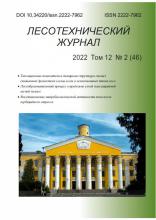Voronezh, Voronezh, Russian Federation
Voronezh, Voronezh, Russian Federation
Voronezh, Voronezh, Russian Federation
Voronezh, Voronezh, Russian Federation
Voronezh, Voronezh, Russian Federation
The article is devoted to problems of forest regeneration and promote natural regeneration in conditions of wood cuttings down, in particular, the designs of tillage tools for primary soil preparation. Tillage equipment operated under such conditions, must possess high permeability and strength, while providing acceptable quality. These requirements correspond to the most ploughs-rippers with disk working bodies. It uses both passive and active working bodies, which brings the first disc plows and heavy harrows, and the second milling tillage. On the basis of the spent constructive analysis of existing tools their classification by drive type (with an active mechanical drive, with an active hydraulic drive, with a passive drive), method of aggregation (rear-mounted mounted, mounted on lateral faces) and to type of the safety mechanism (spring, hydraulic, without safety locks) is resulted.The tools representing various constructive types are in more details considered. Given their technical characteristics: variants of aggregation, type of drive, quantity of working bodies, the width, the diameter of the disk working bodies, depth of processing, type of safety mechanism, weight. The short description of designs and appointment disk rippers is given.On each tool the critical analysis is carried out and conclusions are drawn on possibility of its application in conditions not cleared cuttings down. Based on the analysis formulated the main requirements to prospective disk rippers that will effectively carry out basic preparation of the soil in conditions not cleared cuttings down at height of stubs to 50 sm in various conditions of the Russian Federation.
tillage equipment, disc rippers, plow, reforestation, wood cuttings down, stony soils, classification, analysis
1. Afonichev D.N., Aksenov I.I. Snizhenie negativnogo vozdejstvija mashin na okruzhajushhuju sredu [Reducing the negative impact of cars on the environment]Aktual'nyenapravlenijanauchnyhissledovanij 21 veka [Recent research trends of the 21 century].Voronezh, 2015, no. 4, pp. 9-14.(in Russian). DOI: https://doi.org/10.12737/14071; EDN: https://elibrary.ru/UYRLGL
2. Drapalyuk M.V., Afonichev D.N., Rajecke E.V. Matematicheskoe modelirovanie vzaimodejstvija rychazhno gokorchevatelja s pnemipochvoj [Computer simulation of the arm stump and scarifier with soil] Politematicheskij setevoj jelektronnyj nauchn yjzhurnal Kubansko gogosudarstvennogo agrarnogo universiteta [Multidis ciplinary network electronic scientific journal of the Kuban State Agrarian University]. 2012, no. 77, pp. 202-213. EDN: https://elibrary.ru/OWLKXJ
3. Bartenev I. M., Dontsov I. E., Lysych M. N.Sovremennye ekologicheskisbalansirovannye, resurso- ienergosberegayushchietekhnologiilesovosstanovleniya [Modern environmentally balanced, resource- and energy-saving technologies reforestation]. Voronezh, 2008. 21p.(in Russian). EDN: https://elibrary.ru/NSIRKE
4. Diskovyjryhlitel' [Disc ripper] Available at: http: //xn--80adbjdausesdfbc3bdas.xn-- p1ai/pdf/brochures/T21.pdf
5. Diskovyjryhlitel' [Disc ripper]Available at: http://www.brackeforest.com/ app / projects / brackeAllNew / images / T26aRUWeb.pdf
6. Lysych M.N., Shabanov M.L., Ikonnikov. Perspektivnye konstrukcii lesnyh diskovyhryh litelej [Prospective design of forest disc rippers].Sovremennyenaukoemkietehnologii[Modern high technologies].2016. no. 12-1.pp. 92-97 EDN: https://elibrary.ru/XIHXWL
7. Novak L. Ispol'zovaniemashinvypuskaemykh v Shkol'nomlesnompredpriyatiiMasarykuv les [Using machines produced in the School Forest Enterprise Masarykuv forest]internet-zhurnal «Lesopromyshlennik» [online journal "Timber merchants»] Available at:URL: http://www.lesopromyshlennik.ru/forest/lh_3.html
8. MidiFlex.Available at: URL: http://midiflex.se/index.php?q=ru/o-midiflex Caps. screen. (Accessed 4 January 2016)
9. Sokolov A.I., Kharitonov V.A., Krivenko T.I. Mekhanizatsiya obrabotki pochvy na neraskorchevannykh vyrubkakh v usloviyakhKarelii [Mechanization of soil tillage on uprooted glade in Karelia].Petrozavodsk:Karelsky Scientific Center RAS, 2008, 100 p.(in Russian). EDN: https://elibrary.ru/QKZYDB
10. Walmsley J.D., Godbold D.L. Stump Harvesting for Bioenergy - A Review of the Environmental Impacts. Forestry. 2010, no. 1 (83), pp. 17-38.
11. Hedin I.B. Performance Evaluation of Powered Scarifiers in North Central British Columbia.Available at: URL: https://www.for.gov.bc.ca/hfd/pubs/docs/Frr/Frr103.htm.
12. Löf M., Dey D, Navarro R, Jacobs D. Mechanical site preparation for forest restoration. New Forests. 2012, no. 5-6 (43), pp. 825-848.
13. McLaughlin J.,Gale M., Jurgensen M., Trettin C. Soil organic matter and nitrogen cycling in response to harvesting, mechanical site preparation, and fertilization in a wetland with a mineral substrate. Forest Ecology and Management. 2000, no.1 (129), pp. 7-23. EDN: https://elibrary.ru/AERAZN
14. Nilsson U., Allen H.L. Short- and long-term effects of site preparation, fertilization and vegetation control on growth and stand development of planted loblolly pine. Forest Ecology and Management. 2003, no. 1, pp. 367-377.












